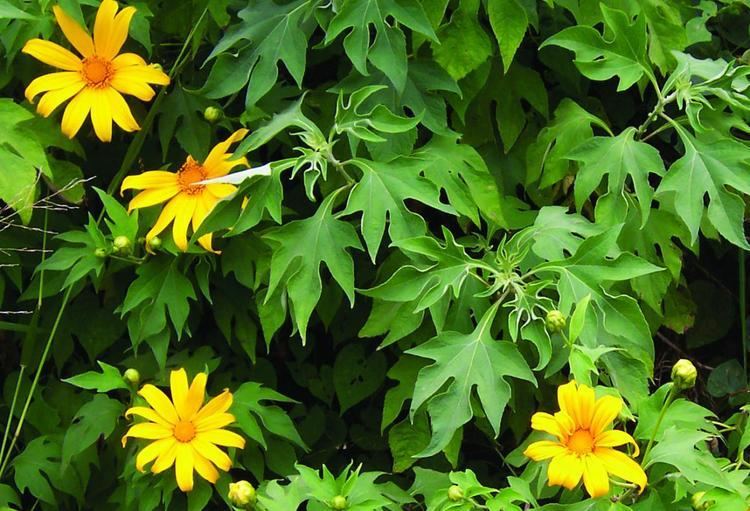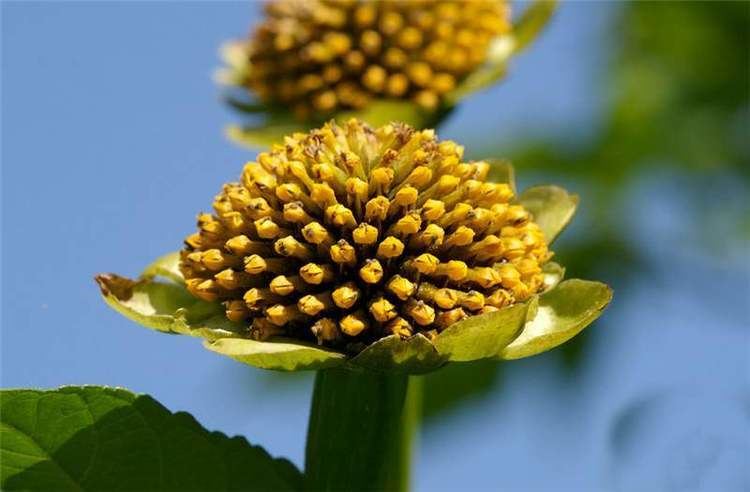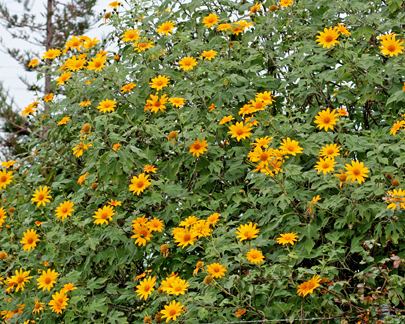Higher classification Tithonia | Scientific name Tithonia diversifolia Rank Species | |
 | ||
Similar Tithonia, Daisy family, Tithonia rotundifolia, Common sunflower, Ipomoea cairica | ||
Tithonia diversifolia is a species of flowering plant in the asteraceae family
Tithonia diversifolia is a species of flowering plant in the Asteraceae family that is commonly known as the tree marigold, Mexican tournesol, Mexican sunflower, Japanese sunflower or Nitobe chrysanthemum. It is native to eastern Mexico and Central America but has a nearly pantropical distribution as an introduced species. Depending on the area they may be either annual or perennial. It has shown great potential in raising the soil fertility in soils depleted in nutrients. Originating in Mexico; research has shown its potential in benefiting poor African farmers. This plant is a weed that grows quickly and has become an option as an affordable alternative to expensive synthetic fertilizers. It has shown to increase plant yields and the soil nutrients of nitrogen (N), phosphorus (P), and potassium (K).
Contents
- Tithonia diversifolia is a species of flowering plant in the asteraceae family
- Description
- History and geography
- Symbolism and uses
- Growing conditions
- Economics
- Time issues
- Constraints to wider adoption
- Practical information
- References

Description

Tithonia diversifolia is 2–3 m (6.6–9.8 ft) in height with upright and sometimes ligneous stalks in the form of woody shrubs. The large, showy flowers are yellow to orange colored and 5–15 cm wide and 10–30 cm long. Leaves are sub-ovate, serrate, acute, 10 to 40 cm long, simply or mostly 3-7 lobed, somewhat glandular, and slightly grayish beneath. The seeds are achenes, 4-angled, and 5mm long. The seeds are spread by wind. The leaves of the plant alternate in sides they grow on, which is where the plant gets the name diversifolia. This is accompanied by flowers which are yellow in colour and range from 6–13 cm in length. It can grow throughout the year and its seeds are spread through way of wind, water, and animals.
History and geography

This plant was originally domesticated in Mexico and spread to other parts of Central and South America and north into the United States. It was brought over to parts of Africa and Asia as an ornamental plant and has become an invasive weed that is widely spread. It is most commonly found in areas with an altitude between 550m and 1950m. It is commonly found scattered among rivers and roadsides. In Asia and Latin America this plant is also referred to as kembang bulan (Indonesian and Javanese), jalacate (Spanish), and buatong (Thai).
Symbolism and uses

Growing conditions

T.diversifolia can grow in many different environmental conditions. It has a moderate drought tolerance. It is ideally grown in areas with an annual rainfall ranging from 1000–2000 mm and a temperature of 15-31 degrees Celsius. This plant does not require a large amount of nutrients because it is able to increase the amount of essential nutrients in the soil itself. As a weed it spreads rapidly which allows farmers to obtain large amounts for the use of fertilization.
Economics

A study on the use of this green fertilizer on tomato plants shows that this is a useful method to increase crop yields in order to benefit the farmer’s wealth. However, this is not without a serious look at the labour requirements. A different study found that, with maize, the overall labour demand versus the financial prospects is not worthwhile, especially in areas of unpredictable rainfalls. This same study also found that growing T. diversifolia on farmer land is not as beneficial from an economic standpoint. Instead, it is better to harvest from an off site location and transport to the fields. From this study, fields that received only a P fertilizer yielded an income to the farmer of $50USD/ha. When only T. diversifolia was applied, this income rose to $494USD/ha. The latter results are high, as another study showed an increase of only to $116USD/ha.
Time issues
Harvesting and distributing this fertilizer over the land by hand is very labour-intensive. The best yields come when T. diversifolia is grown off the land as to not take up growing space. For this reason, when time spent on labour has been factored, this approach may not be beneficial to a farmer.
Constraints to wider adoption
While T. diversifolia does have moderate drought tolerance, the amount of rainfall that the African subtropics receives may not be enough to support the growing of this biomass. T. diversifolia currently grows in humid and semi humid areas in Africa. However, no evidence was found to suggest that it had been attempted in desert conditions.
Practical information
Tithonia diversifolia can be distributed as for biomass green fertilizer. Since this fertilizer requires high labour, it is recommended for use with high value crops such as tomato, kale, carrot, and maize. First, the plant is grown in hedges around the edges of harvest land. It is important though to keep the maximum amount of growing area a farmer has. The green stems (not the woody stems), leaves, and flowers can be removed from the plant at a farmer selected time, though it is recommended that cutting every 5 months will give a plentiful amount of nutrients in the biomass. Biomass refers to when a plants’ foliage is planted into the soil as a dry fertilizer. The biomass can also be used as a mulch and can be left on top of the soil to decompose into the ground. It has been found that the biomass from T. diversifolia breaks down rapidly and releases nutrients quickly. When applying the mulch or biomass to the soil, it should be applied at the minimum amount of one ton to every hectare of land. However, the best yield is given when 5 tons/hectare is applied. The downside here is that a lot of foliage is needed to cover a small area of land because it has a high water content. Mixing this biomass with a synthetic fertilizer will bring higher yields. A study found that when applying tithonia with triple superphosphate (TSP) that the yields increased by 220% compared to a control test containing only an inorganic nitrogen fertilizer (Urea). When using T. diversifolia it should be supplemented with a Mg fertilizer as this nutrient is lacking in quantity when compared to other green fertilizers.
